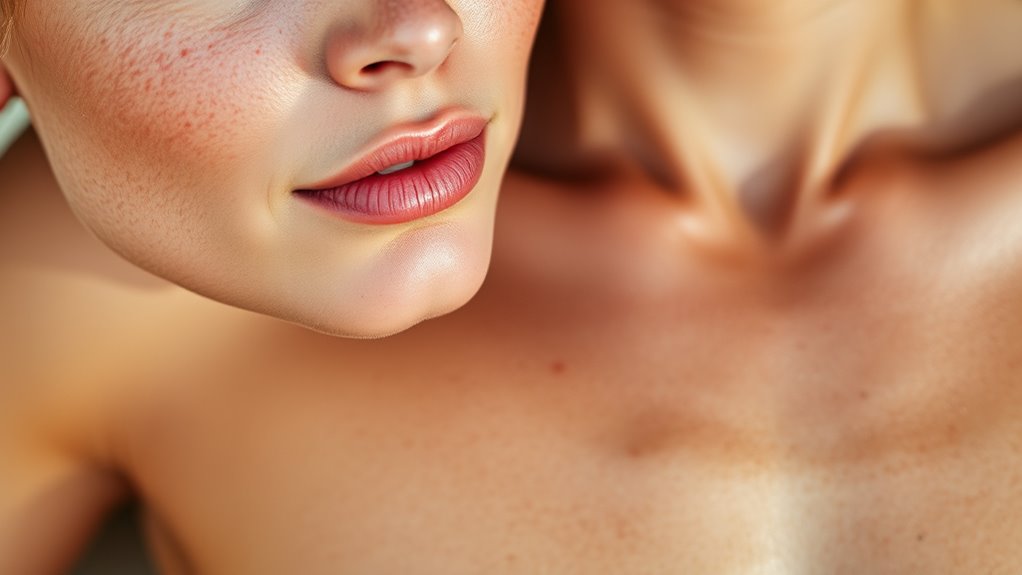After sun exposure, you should apply a broad-spectrum SPF 30+ sunscreen generously on your face, reapplying every two hours, and use a hydrating moisturizer with ingredients like hyaluronic acid to lock in moisture. For your body, wear protective clothing and apply sunscreen to exposed skin. Stay hydrated and use nourishing lotion after showers. Continuing with targeted skincare routines helps keep your skin healthy and resilient long-term.
Key Takeaways
- Use a hydrating moisturizer with hyaluronic acid or glycerin on the face to restore moisture and protect delicate skin.
- Reapply broad-spectrum SPF 30+ sunscreen on the face every two hours during sun exposure.
- Wear protective clothing like long sleeves and a wide-brimmed hat to shield the body from UV rays.
- Apply nourishing lotion to the body after showering to replenish lost moisture and maintain skin resilience.
- Maintain consistent skincare routines and monitor skin health to prevent long-term sun damage and aging.

After spending time in the sun, your skin needs targeted care to recover and stay healthy, but men often overlook the differences between treating their face and body. While your body might seem more resilient, your face is more delicate and vulnerable to sun damage. It’s essential to adjust your sun protection strategies and hydration routines accordingly to prevent long-term issues like premature aging, dark spots, or even skin cancer. The first step is understanding that your face requires a different approach when it comes to sun protection. A broad-spectrum sunscreen with at least SPF 30 should be applied generously, making sure to cover all exposed areas evenly. Don’t forget to reapply every two hours if you’re outdoors for extended periods, especially after sweating or swimming. Your face’s thinner skin absorbs sunscreen more quickly, so neglecting proper application can leave you vulnerable to UV rays. Alongside sun protection, hydration routines play a critical role in skin recovery. After sun exposure, your skin loses moisture, leading to dryness, irritation, and increased sensitivity. To combat this, use a gentle, hydrating moisturizer designed for your face that helps lock in moisture. Ingredients like hyaluronic acid or glycerin are excellent for replenishing lost hydration and restoring your skin’s barrier. Remember, hydration isn’t just about what you put on your skin; drinking plenty of water is essential, especially after sun exposure. Dehydration can make your skin look dull and exacerbate sun damage, so keep a water bottle handy and sip regularly throughout the day. For your body, hydration routines can be more straightforward—using a nourishing body lotion after showering helps replenish moisture, especially if you’ve been sweating or swimming. Its thicker consistency can provide a protective layer, preventing dryness and peeling. When it comes to sun protection for your body, wearing lightweight, long-sleeved clothing or a wide-brimmed hat offers an extra shield against harmful rays. Many men overlook these simple steps, mistakenly thinking they only need sunscreen on their face. But the skin on your body is just as susceptible to UV damage, so extending your sun protection and hydration routines to your entire body is crucial for maintaining healthy skin. Incorporating automation in data analysis can further help you track your skincare routines and monitor skin health over time. Taking care of your skin after sun exposure isn’t complicated, but it does require consistency. Prioritize your face with proper sun protection and targeted hydration routines, and don’t neglect your body. With these small but effective changes, you’ll reduce the risk of long-term damage and keep your skin looking healthy, fresh, and resilient.
Frequently Asked Questions
How Often Should Men Apply After-Sun Products?
You should apply your after-sun product immediately after sun exposure to soothe your skin. Reapply every 2-3 hours if you’re still in the sun or after swimming or sweating. For maximum moisturizer frequency, use a generous layer each time to keep your skin hydrated and help prevent peeling. Consistent after-sun product application ensures your skin recovers faster and stays healthy, especially after prolonged sun exposure.
Can Men Use the Same Skincare Routine for Face and Body?
Using the same skincare routine for your face and body is like trying to fit a square peg into a round hole. Your skin consistency differs, so products might not be compatible. While some multi-purpose products work, it’s best to tailor your routine—use lighter, non-comedogenic products on your face and richer creams on your body. This guarantees proper care and prevents irritation, especially after sun exposure.
Are There Specific Ingredients to Avoid After Sun Exposure?
After sun exposure, you should avoid products with harsh chemicals and fragrance additives, as they can irritate your skin further. Instead, opt for soothing ingredients like aloe vera, chamomile, or ceramides that help repair and hydrate your skin. Check labels carefully and steer clear of alcohol-based products. Your goal is to support your skin’s recovery without causing additional irritation or damage.
How Long Does It Take for Skin to Recover Post-Sun?
While it varies, your skin typically starts healing from sunburn within a few days, but full recovery can take up to a week or more. During this time, sunburn healing involves active skin regeneration, which can be slowed by neglecting proper after-sun care. To speed up recovery, hydrate, avoid further UV exposure, and use soothing products designed for skin repair. Patience is key to restoring your skin’s health.
Is It Necessary to Use Sunscreen Daily After Sunburn?
You should use sunscreen daily after sunburn because of the ongoing sun protection benefits. Even if your skin feels recovered, UV rays can still cause damage and increase your risk of future sunburns or skin issues. Regular sunscreen benefits include preventing premature aging and skin cancer. Make it a habit to protect your skin, especially when spending time outdoors, to keep it healthy and resilient against sun damage.
Conclusion
Now that you know the secret difference between your face and body skin after sun exposure, don’t think you can just ignore it. Neglecting proper care could turn your once-smooth skin into a cracked, leathery battlefield of sun damage—the kind that even superheroes would hide from. So, arm yourself with the right products and routines; your skin’s future depends on it. Trust me, your face and body will thank you for this epic act of skincare heroism.









